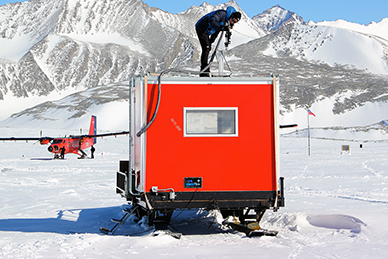- Academics at the Department of Physics, led by Dr. Raúl Cordero, were part of the scientific expedition made in November by the Chilean Antarctic Institute to Unión Glacier and they contributed with valuable measurements of the optical properties of snow.
Although researchers who belong to Dr. Cordero’s group were pioneers in the Unión Glacier area when they carried out several measurements in December 2012, the scientist points out that “the Joint Polar Research Station located at 79 degrees South latitude is a milestone in the Chilean polar research work that will facilitate research at the area and will allow to enhance the national scientific activity in deep Antarctica,” he said.
The Joint Polar Research Station, located at the Unión Glacier in the southern area of Ellsworth Mountains, at about 3,000 kilometers to the south of Punta Arenas and only at 1,000 km from the South Pole, received an important scientific expedition organized by the Chilean Antarctic Institute last November.
Dr. Raúl Cordero led the research team of the Department of Physics of Universidad de Santiago that was part of this expedition and that carried out valuable radiometric measurements in order to describe the optical properties of snow, particularly, its reflectance. The amount of energy reflected by the Antarctic surface is very important, because its variation has an impact on the balance of energy of the continent and, therefore, on the climate of the entire planet.
Dr. Cordero emphasizes that any variation in the current weather conditions in the Antarctica (for example, alterations caused by temperature changes) could spark off mechanisms able to accelerate the climate change; therefore, “eventual reductions in the radiation reflected by the Antarctica into space could contribute to global warming.” “This campaign will provide significant evidence for a better understanding of the Antarctic climatology and its role as a global climate agent,” he added.
The researcher also highlights other aspects of the scientific activity developed at the Unión Glacier. “In spite of the fact that Chile has been conducting research in the Antarctica for decades and has permanent bases on the Antarctic Peninsula, the scientific efforts in the Antarctic Circle (i.e., beyond 66 degrees South latitude) have been rather limited.”
Although researchers who belong to Dr. Cordero’s group were pioneers in the Unión Glacier area when they carried out several measurements in December 2012, the scientist points out that “the Joint Polar Research Station located at 79 degrees South latitude is a milestone in the Chilean polar research work that will facilitate research at the area and will allow to enhance the national scientific activity in deep Antarctica,” he concluded.
Translated by Marcela Contreras



